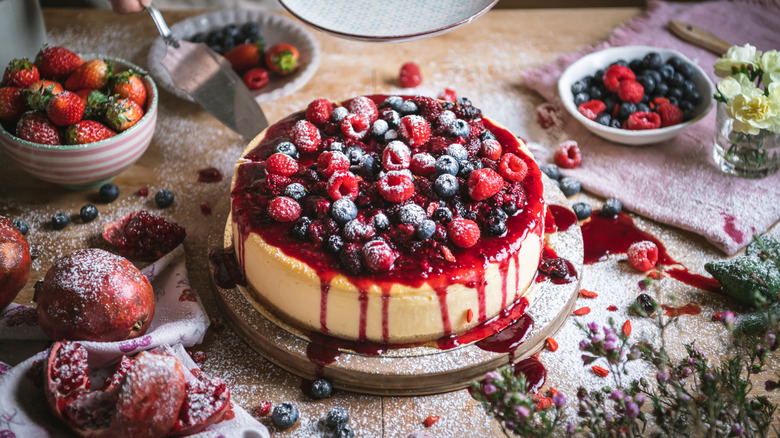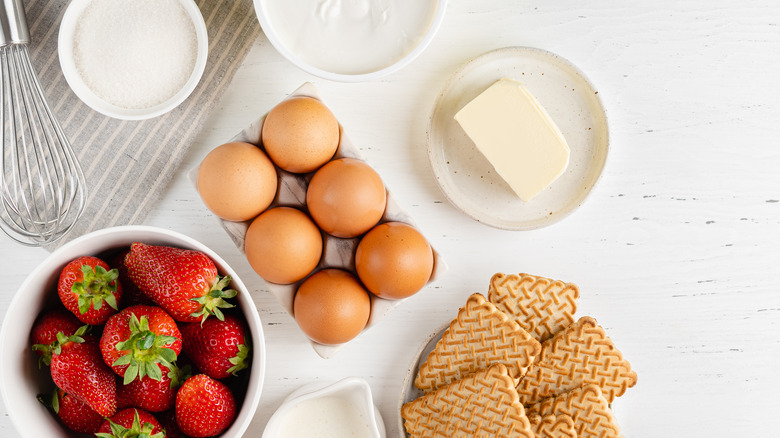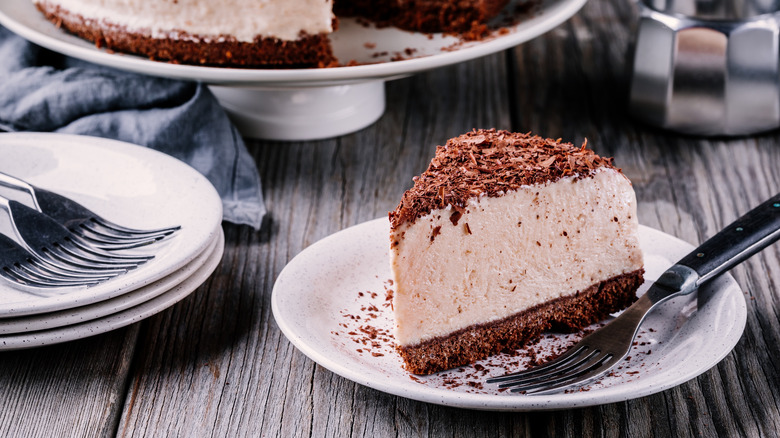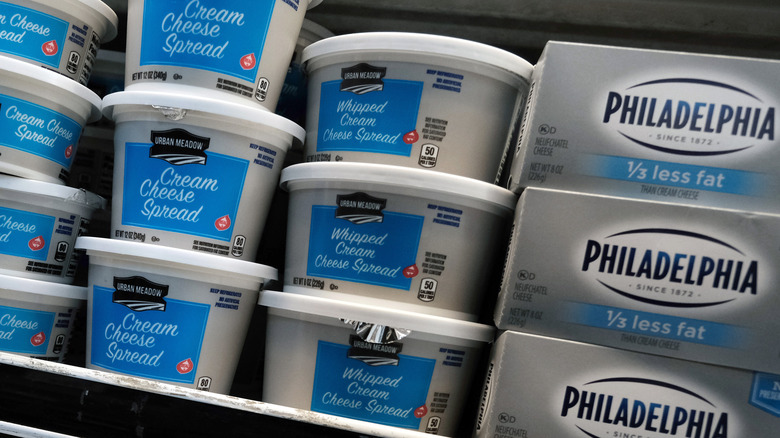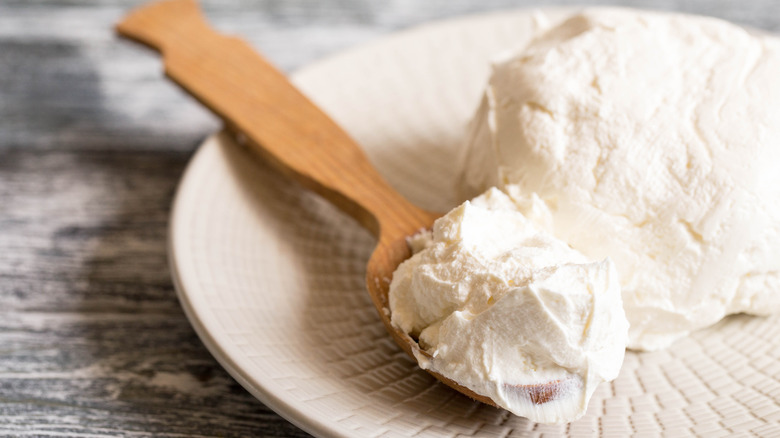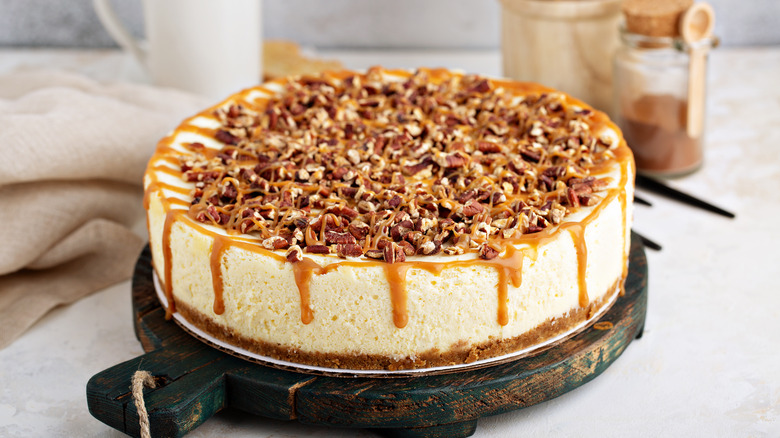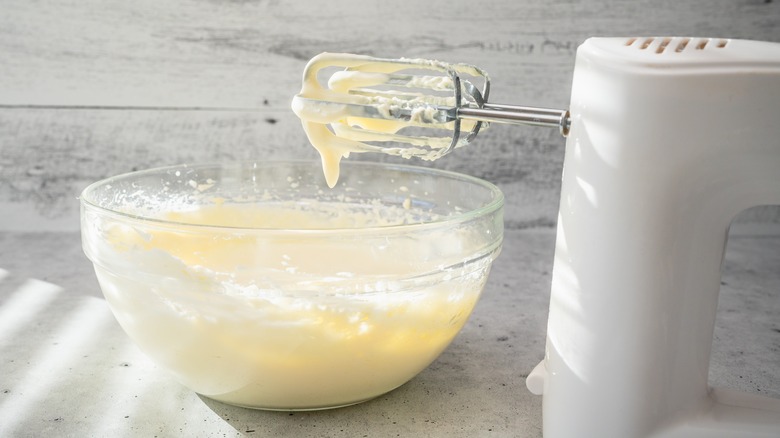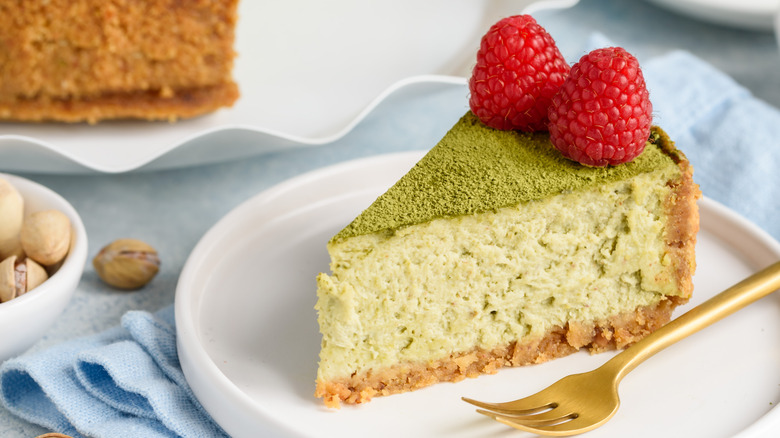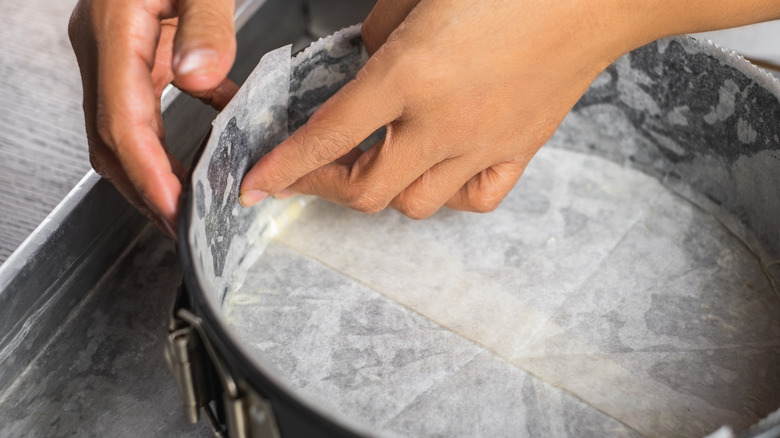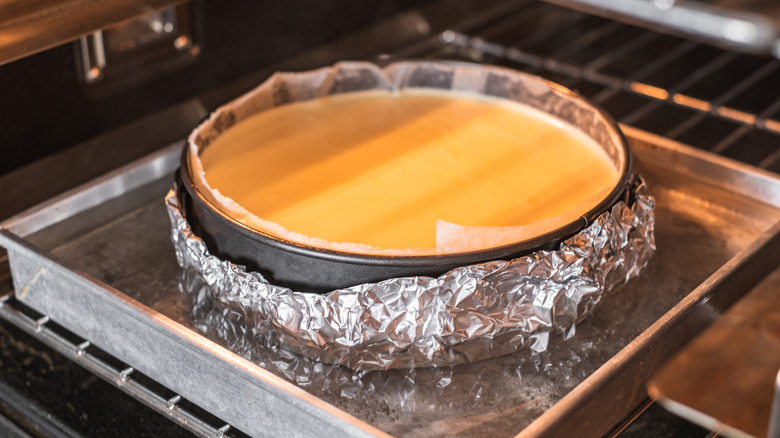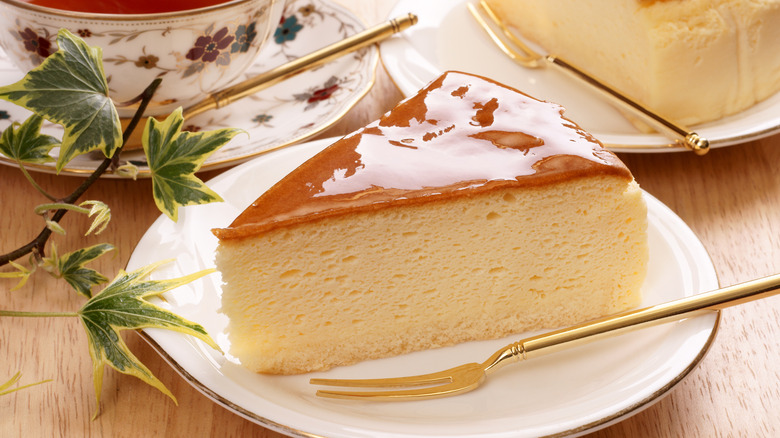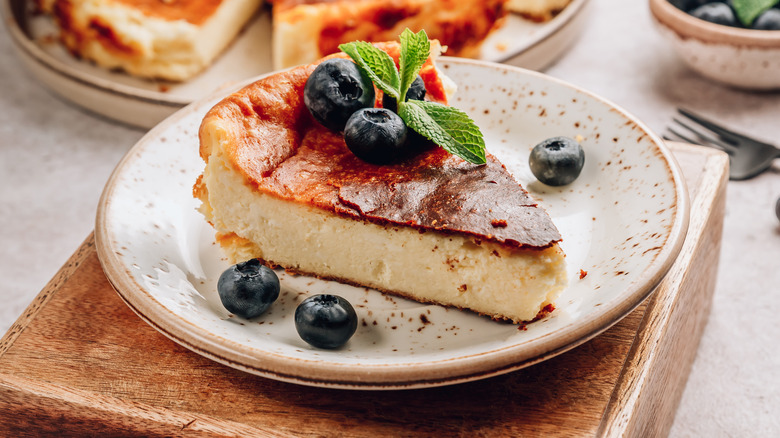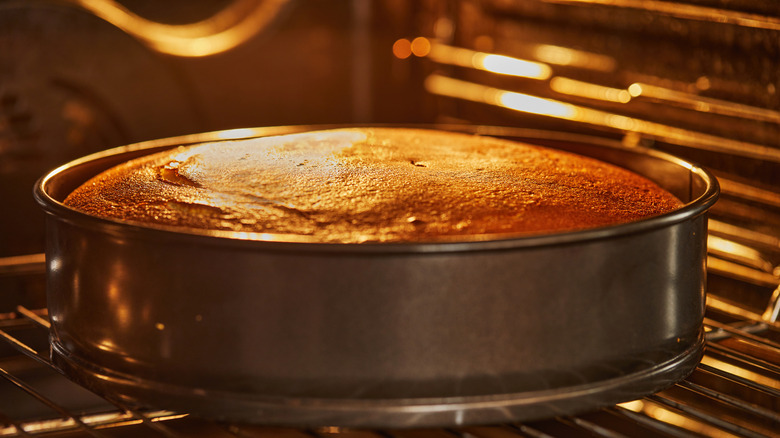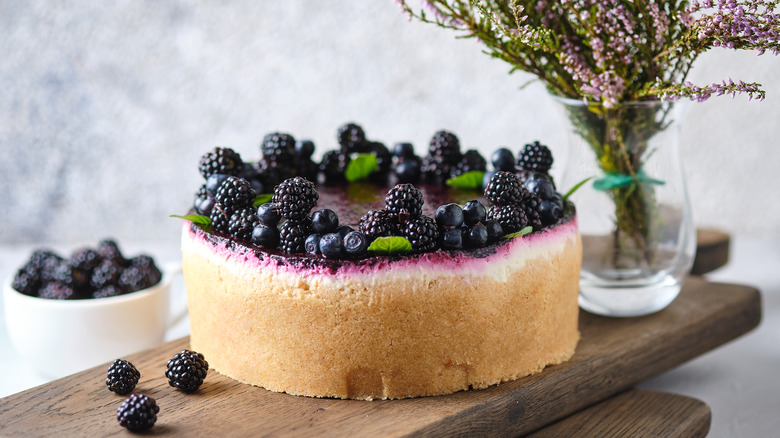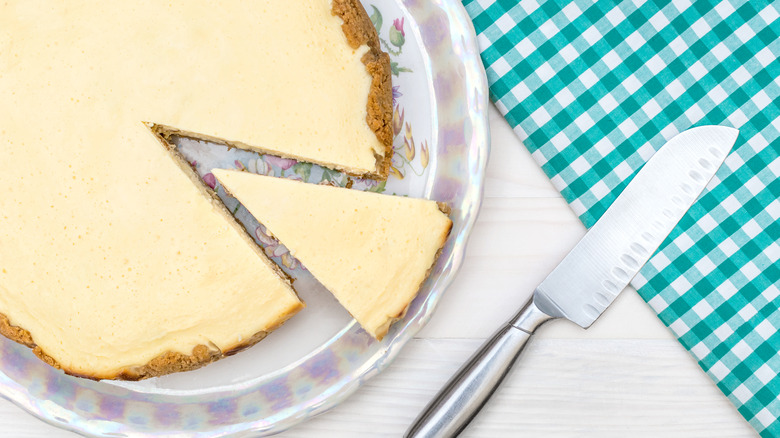14 Tips You Need To Bake The Perfect Cheesecake
If you're anything like us, the word "cheesecake" has you drooling and prepared to go to the ends of the Earth to savor a slice. It's the kind of dessert that holds immense power: Satisfying a family or causing a fight over the last portion — cheesecake can do both.
While you may envisage cheesecake as the epitome of an all-American dessert, the history of this crowd-pleaser extends back to the ancient Greeks, per Greek City Times. That primitive cheesecake was made from baked pounded cheese, honey, and flour and dates back to the fifth century B.C. A mere hundred years later, the dessert was given to athletes during the first Olympic games to energize them. We bet athletes of the modern era would appreciate that treatment!
The decadent cheesecake spread far and wide, gradually evolving until, in 1880, dairyman William Lawrence invented what we know as cream cheese (via The New York Times), and the classic New York-style cheesecake took over in popularity. Many variations of cheesecake survive, from traditional European recipes to ultra-chocolatey and decadent modern indulgences. While the dessert remains highly adaptable, mastering the basics is always advantageous. Baking a cheesecake with a buttery graham cracker crust and a dense, creamy, rich custard dusted with sugar that doesn't have cracks is more arduous than you may think. To help you out, we'll explore some straightforward tips to perfect the classic baked cheesecake and elaborate on how to artfully improve on the fundamentals.
Bake with room temperature ingredients
One of the best things about cheesecake is the texture: velvety, smooth, thick, creamy, and with a beautiful melt-in-the-mouth sweetness. Without these characteristics, cheesecake would miss the air of indulgence we know and love. Achieving this silky texture is a multi-step process that starts before you so much as turn on the oven by first and foremost ensuring that you use room-temperature ingredients for cheesecake.
Although you've likely been tempted to use cold eggs, butter, or cream cheese in your bakes to save time, it may have more consequences than you realize. Butter and cream cheese are hard when cold, so it's hard to whip them until you reach the correct creamy consistency. You also run the risk of lumps in your cheesecake mix. Instead, leave them on the counter to soften for at least an hour before cooking. Likewise, cold eggs can ruin your cheesecake since room-temperature eggs are vital for a light and airy texture in baked goods.
Experiment with different flavors for the base
While the decadent and creamy cheesecake filling usually gets most of the love, the biscuit base is just as vital. Neither would taste as good without the other, and this textural play is one of the most glorious things about cheesecake. It doesn't matter if you prefer your base to be thick or thin or if you like the crust to extend up the sides. What does matter is that it's rich, buttery, and has just the right about of bite.
A graham cracker crust is a classic for a reason. We get it. Graham crackers are accessible and have a pleasing nutty, honey-sweet, cinnamon-spiced flavor that matches exquisitely with the creamy, vanilla-scented flavor of the filling. Notwithstanding that fact, sometimes it's good to experiment and mix things up. For example, we adore the buttery-softness of Scottish shortbread biscuits with strawberry cheesecake, and a luscious Oreo cheesecake is a chocolate sensation that can't go wrong. Varying the cheesecake crust is an easy and effective way to make your cheesecake stand out from the crowd.
Don't use whipped cream cheese
There's no doubt that cream cheese is the most commonly used variety of cheese found across all manner of cheesecakes, showing up in anything from a fusion tiramisu cheesecake to a tart raspberry-swirl cheesecake. The importance of cream cheese can't be understated; the mildly sweet and tangy flavor is the base note of most great cheesecakes that balances all other flavors. You may not realize there are many different types of cream cheese: low-fat, fat-free, unpasteurized, cream cheese spread, whipped cream cheese, and cream cheese blocks. It's crucial that you use the correct one for an optimum result.
While whipped cream cheese and cream cheese blocks are fundamentally similar, there are differences. Compared to blocks of cream cheese, the whipped variety has additional ingredients (whey and stabilizers like lactic acid). As the name suggests, it is beaten during processing to make it smooth. Although this may sound beneficial, too much aeration and the extra moisture introduced by excess whey negatively impacts the texture. Additionally, the extra fat contributed by supplementary milk and cream in the block variety helps make cheesecake beautifully creamy. In short, never use whipped cream cheese for cheesecake; it's best reserved for bagels. For desserts like cheesecake and cream cheese frosting, buy the cream cheese in a block.
Try cheese varieties beyond cream cheese
The smooth and creamy texture of cream cheese combined with its rich and mildly sweet flavor makes it hands-down the most popular cheese used in desserts, including cheesecake, across North America. We won't dispute the reigning champion since it's a classic for a reason. However, other cuisines use alternative kinds of cheese for this delectable dessert that are worth exploring.
Soft Italian cheeses like mascarpone are widespread due to their milky, rich, and tangy nature. The main difference between mascarpone and cream cheese is the fat content. Cream cheese must contain more than 33% fat while maintaining under 55% moisture content. Comparatively, mascarpone cheese has an average fat content between 60% and 75% (via Cheese.com), making it a luxurious choice for rich, buttery, and creamy desserts. Ricotta is another similar Italian cheese commonly used in traditional Italian ricotta cheesecake or combined with cream cheese to make an American ricotta cheesecake. Meanwhile, quark and twaróg, both similar, are slightly more obscure kinds of cheese that can be compared to farmer cheese or cottage cheese. The latter is the main ingredient in sernik, a traditional Polish cheesecake with a tart flavor.
As you can see, various cheese has different properties and flavors, each of which lends distinctive and delicious results. We suggest you explore the breadth of choice available and experiment by combining different ratios of each cheese to create a gorgeous cheesecake.
Avoid using low-fat ingredients
It's no secret that cheesecake isn't a diet food. Crunchy, nutty, and spiced crackers mixed with copious amounts of rich melted butter in the crust are already delightfully tempting. Add the layers of sweet, dense, and silky custard, and you have a decidedly extravagant dessert. But nobody eats cheesecake to be healthy, do they? That's why we always recommend using full-fat cheese when baking cheesecake — anything else, and you'll sacrifice both flavor and texture.
According to a study published in the International Journal of Food Science and Technology, researchers have found that using low-fat cheese when making cheesecake adversely affects the texture. Conversely, full-fat cream cheese maintains the cheesecake's trademark density and smooth creaminess. It doesn't just end there, though. Low-fat cream cheese also contains more moisture, which can often cause the cheesecake to have a runnier, less thick texture or even struggle to set up properly.
Mix your ingredients thoroughly, but not too much
Unfortunately, baking is rarely straightforward. While we wouldn't argue that baking is an art, it's also a science. The exact quantities of ingredients you use, the way you mix the elements, and the temperature you bake your desserts each impact the final result. In the case of cheesecake, mixing the custard is one of the most salient steps in the process and comes with its fair share of pitfalls.
If you undermix the ingredients for cheesecake, you hazard a lumpy batter as opposed to the smooth, velvety texture of our dreams. Worse yet, failing to incorporate the elements correctly can risk the flavor and texture differing widely between bites. Furthermore, overmixing your batter can aerate the mixture (great for cakes, not so good for cheesecakes), potentially causing air bubbles, shrinkage, or cracking. So, what's the best technique to prevent these issues? Try mixing your batter in two stages: First, whip the cream cheese at medium speed for about four minutes until smooth and creamy. Next, add your other ingredients and employ a slow pace to mix just until the ingredients have combined, no further.
Add extra flavor to your filling
It's time to get creative. We know everyone loves a simple vanilla-scented New York cheesecake, but for the more adventurous cooks of the world, once you have a handle on the basics, you can begin to experiment. There are many ways to weave additional flavors into your filling, from mixing the flavoring throughout the entire custard, resulting in a uniform taste, to adding whole fruits, rippled sauces, or even layers of curd.
A clever and effective way of adding flavor is through spice, like in gingerbread cheesecake; cinnamon, nutmeg, and other warming spices are added to the custard, while whole gingerbread biscuits artfully decorate the top. Or why not use the same method to subvert the pumpkin pie into a pumpkin-spiced cheesecake? On the other hand, culinary-grade matcha delivers a beautifully earthy sweetness to the traditionally fluffy Japanese cheesecake and lends an attention-grabbing vibrant color. A more classic choice may be fruits: Opt for blueberry cheesecake, raspberry ripple, or a layer of lemon curd for a crowd-pleasing party dessert.
Use a springform pan for easy serving
There are some pieces of kitchen equipment that make our lives so much easier. Like non-stick pans, springform cake tins are one of those lifesavers. Springform pans generally have a latch on the side, which allows easy separation between the bottom and sides of the pan. This design is singularly practical when baking cheesecake, as once the dessert has cooled, it's easy to un-latch the pan and separate the base from the side rim. Additionally, once the cheesecake is free from the pan, it's effortless to cut neatly.
The only downside to springform pans is that they can experience leaking due to the lack of a seal between the base and the rim. To prevent this, it's good practice to line the inside of the pan with parchment paper (creating a seal) and further reinforce the exterior with a layer of aluminum foil.
Bake in a bain-marie
The culinary world frequently employs obscure terms that the average home cook may not know. Bain-marie, pronounced "ban-ma-ree," is a French term that directly translates to "Mary's bath" but is better known as a hot water bath, per Wasserstrom. The term originates from the method's inventor, Mary, an early alchemist living around the first to third century A.D. We still use her invention in the modern kitchen when baking delicate goods like terrine, mousse, and cheesecakes.
The French term can give the illusion that a bain-marie is complicated to execute but forgoing this step could be why your cheesecake cracks, sinks in the middle, or has tough and rubbery edges. To create a bain-marie, reinforce the sides of your springform pan with tin foil to prevent leakage. Place the springform pan into a large, deep-sided baking dish, and carefully pour boiling water (212 F) into the baking dish until it reaches halfway up the springform pan. Slide the bain-marie into a pre-heated oven, sit back, and wait.
The bain-marie works by controlled heat to gently and evenly cook your desserts. In the case of custards (like cheesecake), it stops the filling from becoming hot too quickly and curdling or extreme temperature changes that cause sinking (via Rouxbe Culinary School).
Check if it's cooked with a jiggle test
Like most baked goods, cheesecake suffers when either underbaked or overbaked. It can be daunting, but it's good advice to get comfortable with the best techniques to tell when your cheesecake has finished cooking. We recommend you avoid repeatedly opening the oven door to check on your dessert. Limit it to once, as similarly to cakes, the changing temperature and pressure interrupt the rising process and cause sinking. Instead, use your recipe as a guideline and set a timer to alert you when it's time to take out the cheesecake.
To check that your cheesecake is done, carefully shake the cheesecake. While the outer edges should be puffy and firm, the middle should have a subtle jiggle. If no part of the cheesecake jiggles, you've likely overcooked it, while if the cheesecake is wobbly throughout, it needs a few more minutes. You can also use a quick-read thermometer; the internal temperature should read 150 F. However, most cooks prefer the jiggle method as it maintains the pristine appearance of the cheesecake.
Don't be afraid to caramelize the top
You may have noticed that a typical New York cheesecake has a light, creamy white color throughout. So, what do we mean when we suggest caramelizing the top of your cheesecake? Although we don't recommend following this advice for every recipe, one cheesecake that's taken the world by storm has a distinctive caramelized crust: Basque cheesecake. The burnt-topped, rich, creamy, crustless cheesecake is worth trying for every dessert aficionado. We suspect it may even become your new favorite.
According to SBS, Basque cheesecake originates from the Spanish region of San Sebastian, when in 1990, chef Santiago Rivera invented the now beloved "burnt" cheesecake. But is Basque cheesecake really burnt? The answer is no: it's caramelized. Basque cheesecake is cooked differently from a typical American interpretation; high temperatures are crucial to creating the unusual caramelized crust. It creates a toasty, nutty flavor that we believe is worth trying.
Cool your cheesecake in the oven
We're willing to bet that everyone has experienced it once; you take your cheesecake out of the oven and stare wondrously at the masterpiece you've created, and then, as if out of nowhere, cracks appear on the surface of the cheesecake. Of course, you can always cover the fissure with whipped cream or fruit, but it suggests that something has gone wrong in the cooking process.
It turns out that although we all want to take out our forks and dig into the cheesecake right away, the foremost step you can't skip with homemade cheesecake is patience. One of the most monumental risk factors for unsightly cracks in cheesecake is a drastic and sudden change in temperature, meaning that you should cool the cheesecake gradually. It's often recommended to turn off the oven, open the door slightly, and leave the cheesecake inside for about 30 minutes. This step will allow the cheesecake to "acclimatize" to the room, and (fingers crossed) you should avoid cracks.
Wait to cover the cheesecake
"Soggy bottom" is an exceedingly strange term usually associated with things baked with pastry, like pie. As per The Telegraph, the idiom first found popularity in 2010, when Great British Bake Off hosts Paul Hollywood and Mary Berry described baked goods suffering from a soggy crust. Even though cheesecakes generally have a buttery, nutty and crunchy base, it's possible to have a cheesecake with a soggy bottom, too.
There are many causes for this mishap to occur. Firstly, the water bath could leak into the cheesecake pan (be sure to line it carefully with aluminum foil). Secondly, the filling could seep into the cracker base (be sure to press the crust down firmly).
Covering a cheesecake while it's still warm can have the same result. If the cheesecake is still retaining heat, covering it will only cause moisture to build up and soak down to the crust, rendering a soggy bottom. Who want's that? Instead, leave your cheesecake on a cooling rack for at least one hour before covering it with plastic wrap and putting it in the fridge.
Cut clean slices with a warmed knife
In an age where increasingly more people proudly post their creations on social media, the adage "we eat with our eyes" rings more true than ever. Cheesecake is the ideal dessert to serve for a large gathering, but you may experience a disaster when cutting through the layers. It's all too common that the first slice is neat and clean, and then the second one has crumbs from the base smeared all over the lovely white, creamy custard layer. It may be a small detail, but a messy presentation — especially for a dessert that has the potential to be a true showstopper like cheesecake — can ruin the experience.
Thankfully, there's an easy way to ensure your upcoming cheesecake cuts smoothly to reveal beautifully clean and neat magazine-worthy slices. Per What's Cooking America, the key is keeping your knife clean and smooth by dipping it into hot water and wiping it with a clean towel in between cuts. This approach prevents any crumbs or cream from transferring to the next slice. Using unflavored dental floss to cut the cheesecake is an effective method, too.
